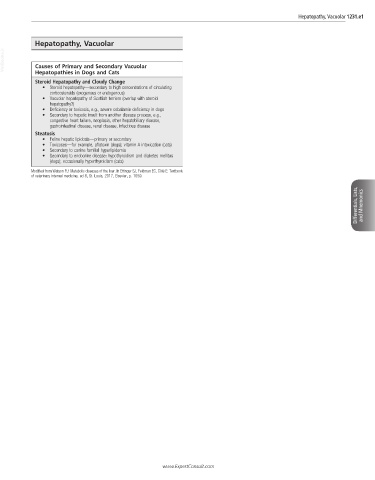Page 2478 - Cote clinical veterinary advisor dogs and cats 4th
P. 2478
Hepatopathy, Vacuolar 1231.e1
Hepatopathy, Vacuolar
VetBooks.ir Causes of Primary and Secondary Vacuolar
Hepatopathies in Dogs and Cats
Steroid Hepatopathy and Cloudy Change
• Steroid hepatopathy—secondary to high concentrations of circulating
corticosteroids (exogenous or endogenous)
• Vacuolar hepatopathy of Scottish terriers (overlap with steroid
hepatopathy?)
• Deficiency or toxicosis, e.g., severe cobalamin deficiency in dogs
• Secondary to hepatic insult from another disease process, e.g.,
congestive heart failure, neoplasia, other hepatobiliary disease,
gastrointestinal disease, renal disease, infectious disease
Steatosis
• Feline hepatic lipidosis—primary or secondary
• Toxicoses—for example, aflatoxin (dogs); vitamin A intoxication (cats)
• Secondary to canine familial hyperlipidemia
• Secondary to endocrine disease: hypothyroidism and diabetes mellitus
(dogs); occasionally hyperthyroidism (cats)
Modified from Watson PJ: Metabolic diseases of the liver. In Ettinger SJ, Feldman EC, Côté E: Textbook
of veterinary internal medicine, ed 8, St. Louis, 2017, Elsevier, p. 1659.
Differentials, Lists, and Mnemonics
www.ExpertConsult.com

